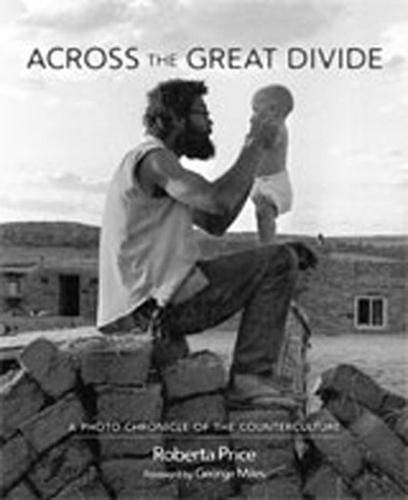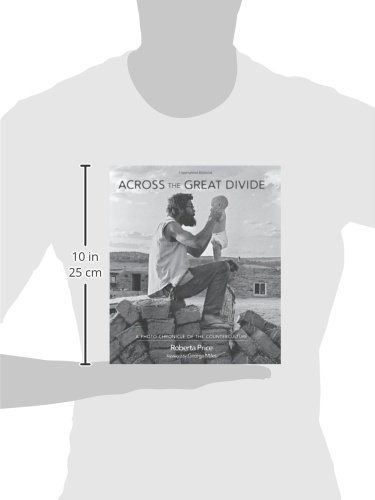


Across the Great Divide: A Photo Chronicle of the Counterculture
M**N
Pollyanna in communeland!
The problem I have is the same as with most photo books--too few photographs. The author took 3000 pictures but the book contains only 121. As to the book itself, the paper is high quality and the photos clear.
R**Y
Four Stars
That's my Brother in Law and nephew on the cover!!!
S**B
Not what I expected!
I thought this would have been more of the culture of the 60's and 70's but it turned out to be more of one commune, photo wise, its okay. This seemed more about one womens relived youth and wishfulness.
D**S
A Stunning Achievement
Roberta Price's lucid and luminous "photo chronicle" is like opening a time capsule. It is a rare, timely and ultimately up-lifting view of the counter-culture in pre-9/11 America, before the (apparent) triumph of corporatism and the national security state. In the interest of full disclosure, I am still a resident on one of the communes that Price documented in the late 60s and early 70s. Her book is a tribute to her considerable charm and persistence in obtaining these riveting images. Price had to brave gale-force winds of hostility from the communards. At the time, one of our biggest fears was that "mass media" would sensationalize, marginalize and eventually crush our fledgling utopian dreams. We knew our venture was fragile and that publicity would inevitably bring hordes of energy-draining gawkers, thrill-seekers and dead-enders. Price has discreetly waited over 40 years to unleash these quietly incendiary photos. We all owe Price a debt of gratitude for having the foresight to recognize that the " back to the land" movement, for better or for worse, deserved to be part of the American historical record. Luckily she had the patience and resourcefulness to get the job done. Looking at some of her photos today, I'm struck by their eerie resonance with the current Occupy Wall Street movement. Her poignant photos of the Vietnam War protests, with all their rage and theatricality, are uncannily similar to the recent confrontations in Oakland and elsewhere. In the 1960s we weren't just protesting the war. For many of us, our attitude might have been more akin to Marlon Brando in the biker movie The Wild One. When asked what he was rebelling against, Brando's character replied: "Whatta ya got?" As we gained a bit more maturity, we realized that nihilism and being repeatedly beaten and tear-gassed were ultimately unsatisfying. The new motto became: You're either part of the problem or you're part of the solution. Our solution was to leave it all behind and begin the tricky task of creating a "separate reality." In our quest for a more authentic existence in the soul-eroding rampant materialism of the post-WWII era, many thousands of our compatriots came to the same conclusion: a major part of society's ills came from our loss of contact with the natural world. Take note all you Generation X hackers, slackers and geeks. For the new pioneers it was good-bye concrete jungles and hello to the wilderness and the wide-open vistas of the West. I'm reminded of an old New Yorker cartoon. Two chickens are enjoying cocktails while lounging by a pool. One chicken says to the other: "Once I saw that 'Free Range' sign, I never looked back." In summary, Roberta Price's book is a joy and a stunning achievement. As an extra bonus, she is also a talented writer and poet. Her clear-eyed accompanying text is both crisp and fluid. Although the photographs speak for themselves, her narrative deftly places the images in their proper context. With a keen eye and highly refined sensibilities, Price has managed to capture perfectly that exuberant bygone era... a time rife with seemingly endless possibilities and the exhilaration of discovering new realms of both personal and collective freedom. Oh yeah, one last thing...we were right.
C**R
Tell It Like It Was
This book knocked me out. It's clear that as the baby boomers retire we are going to see plenty of explanations of the times and by products of that population explosion, trying to make pieces of the past fit an undefinable present. Instead of wasting time with all that, "Across the Great Divide" simply tells it like is was. No frills. And in the process, Roberta Price's beautiful and revealing photo chronicle of life on the communes in the awe inspiring mountain country of southern Colorado and northern New Mexico in the late 1960s and 1970s goes well beyond the talking. Her pictures open an unadorned window on that fragile moment in our country's history when some of us actually believed we could change the world, and we took a crack at it. Without hiding from or playing up the outrageous appearances and robust lifestyles of these untamed children of the greatest generation, Price's stunning photographs drill deep down in the wildness to expose a level of creative energy that is hard to imagine coming out of today's graduating classes. Her writing is straightforward and skillful, understated, letting the facts tell the story. I was there and you can take from me, if you want to get a feeling for what it was like to live those days, this book is a great place to start.
H**R
What Real Freedom Looks Like
In the 1960s I was a mild-mannered grad student in sociology at UW/Madison - until the life-changing events of 1968, culminating in the Chicago police riot at the Democratic National Convention. Like millions of other angry and alienated young Americans at the time (and millions now, for that matter), I desperately wanted to find a better way of living. I found myself drawn to the "back-to-the-land" movement, then in its counterculture infancy - though with deep roots in American history. I did some journalism about it (Esquire, September 1970) and a lot of "participation-observation" research for my Ph.D. dissertation, eventually published as The Children of Prosperity: Thirteen Modern American Communes (St. Martin's Press, 1977).Roberta Price's Across the Great Divide perfectly captures the spirit of the times in ways I was never able to do. I encountered many of the same people, places and events that Price documents, but paranoia struck deep then; the minute I brought out my camera, it was usually goodbye. Unlike Price, who lived the life herself for many years and was widely trusted, I was more like a tourist, only able to capture the joys and hardships of what I saw in words. Nothing in my personal photo archive of that period would make the cut of this book, which sets a new standard for understanding a very important but neglected - in fact suppressed - period of our national history. Price's luminous, authentic images show us what real freedom looked like for young Americans circa 1970.Today, the whole world is crying out against military oppression, industrial pollution and corporate serfdom, and yearning for new paths to participatory democracy, cooperative communities, and economic self-sufficiency. The 60s communards may have been young and reckless, but they gave us enduring role models and lessons for the future in recovering the American Dream. Every public library and personal collection aspiring to document major shifts in history should have this book.
Trustpilot
4 days ago
1 week ago
5 days ago
2 months ago